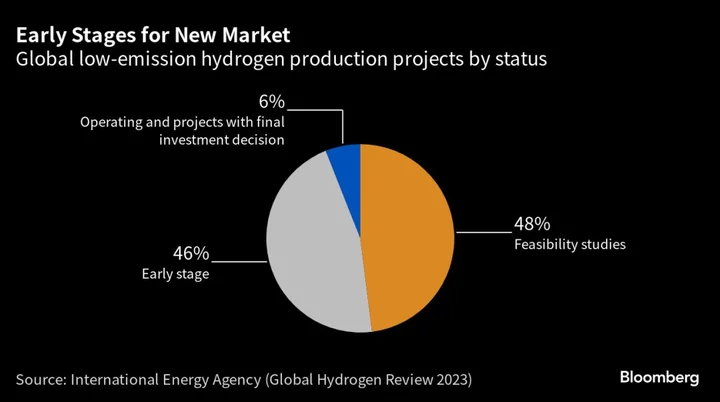In 2021, the UK set out a bold ambition to become a ‘global leader on hydrogen’ by 2030. Two years later, delivery is falling short and it’s dropped behind European rivals jostling for a piece of the market.
Britain’s target for 10 gigawatts of hydrogen would make it one of Europe’s top producers by the end of the decade, but a lack of clarity on subsidies means projects are not reaching financial approval.
Meanwhile Germany, Europe’s largest economy, has set aside €50 billion to support industry shifting to the clean fuel and the Netherlands is retrofitting a network of pipelines from the port of Rotterdam, straight into Germany’s industrial heartland.
That means the UK is slipping, and both countries have overtaken it in development, according to the Energy Networks Association, an industry body. The UK has dropped to eighth place from second, it said last month, referring to “missed opportunities” and uncertainty around policies and funding.
Such criticisms are part of a pattern of frustration among investors and business leaders about the government’s green ambitions.
That’s linked to concerns about the UK’s plan to achieve net zero by 2050 as well as Prime Minister Rishi Sunak’s environmental credentials. In the past month alone, both have taken a bashing after Sunak controversially pushed back some net-zero steps and the offshore wind energy sector suffered an embarrassing setback, undermining its position as a global leader.
The UK was quick to spot the need to build a market for hydrogen, and could lead Europe in clean hydrogen production volume by 2030, based on announced projects tracked in BloombergNEF’s Hydrogen Project Database.
But within the industry, there’s concern. Timelines have slipped and buyers have been shy to sign up to supply contracts, which are seen as too expensive without subsidies.
“While the UK has spent time developing a complex support model for hydrogen, neighboring countries have been proceeding with projects,” Steve Scrimshaw, vice president of Siemens Energy UK & Ireland, said at an event on the sidelines of the annual conference of Sunak’s Conservative Party this week. “We are yet to award anything in the UK over 5 megawatts whereas the scale of other green hydrogen projects is around 100 megawatts so the scale has been growing.”
Scrimshaw also bemoaned slow progress in building electrolyzers, which produce hydrogen by splitting water molecules using electricity.
Hydrogen, which can be burned to create energy without releasing carbon dioxide, has become a backbone of many decarbonization plans partly because of the potential to use existing gas networks to bring the fuel to the grid.
That’s a big advantage for governments looking to keep key industries afloat while replacing fossil fuels. Hydrogen can be used where other renewables — such as wind and solar — aren’t suitable, because certain processes can’t easily be electrified.
Given that, it’s become a global phenomenon: more than 1,000 projects have been announced, and investment commitments up to 2030 amount to some $320 billion, according to Nomura.
The UK must make sure there’s “sufficient budget committed and allocated, as both the US and the European Union have bigger balance sheets,” said Viral Gathani of Essar Capital, owner of the UK’s Stanlow Refinery. “Both are starting later, but with much more money.”
Essar plans to have a unit at Stanlow to produce blue hydrogen, made by splitting natural gas into hydrogen and carbon dioxide. It’s cheaper than green hydrogen, which uses renewables.
The UK has a good opportunity given its old oil and gas fields and infrastructure, said Gathani. “The challenge now is to see projects through.”
The financial part of the challenge was exposed earlier this month at an event in Berlin, where the UK’s energy efficiency minister, Martin Callanan, was signing a hydrogen agreement with Germany.
Asked what the UK sets aside for hydrogen, Callanan cited two programs of over £240 million and £350 million. That compares with about €3.8 billion Germany earmarked in a special climate and transformation fund for the hydrogen industry just next year.
The UK said it has a “comprehensive” set of policy commitments to support investment in hydrogen.
While most of the UK’s hydrogen production will initially be used for internal consumption, many continental countries — as well as suppliers outside Europe — are eying Germany as the nation shifts its energy use away from Russia.
Spain’s Cepsa SA is one example, counting on domestic solar and wind generation to feed German hydrogen needs. “We have a perfect match,” said Carlos Barrasa, Cepsa’s executive vice president for commercial and clean energies.
Read Also: Europe’s Manufacturers Are Struggling to Shift Away From Gas
Also part of that plan is the port of Rotterdam, the region’s biggest commodity hub. There, authorities and major energy companies are developing a large-scale network that will provide support to hydrogen production and pipelines to transport the fuel.
The UK “will have to move boldly and quickly, as being seen as a destination of choice is key to developing any new industry,” said Martin Bradley, Macquarie Asset Management’s head of infrastructure in Europe, the Middle East and Africa. “With many other nations who would love to drink from the UK’s straw lining up, the race is well underway.”
Author: Priscila Azevedo Rocha, Elena Mazneva and Petra Sorge









